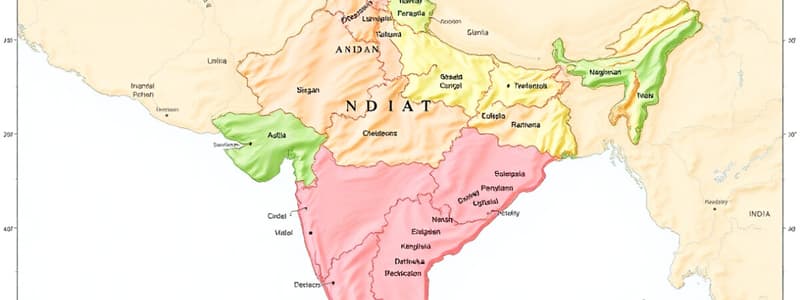Podcast
Questions and Answers
What is the meaning of the term 'Himalaya'?
What is the meaning of the term 'Himalaya'?
- The Land of Rivers
- The Abode of Snow (correct)
- The Mountain of Clouds
- The Extreme North
Which of the following is the southernmost point of the Indian mainland?
Which of the following is the southernmost point of the Indian mainland?
- Cape Comorin (correct)
- Indira Col
- Pygmalion Point
- Indira Point
How wide are the Northern Mountains at their widest point in Kashmir?
How wide are the Northern Mountains at their widest point in Kashmir?
- 500 km (correct)
- 300 km
- 200 km
- 700 km
What is the longitudinal difference between the westernmost and easternmost points of India?
What is the longitudinal difference between the westernmost and easternmost points of India?
Which division is known for its prominent ranges including Zaskar and Karakoram?
Which division is known for its prominent ranges including Zaskar and Karakoram?
What is India's Central Meridian longitude?
What is India's Central Meridian longitude?
Which of the following are included in India's major physiographic divisions?
Which of the following are included in India's major physiographic divisions?
What is the north-south extent of India?
What is the north-south extent of India?
Which of the following features is associated with the Trans-Himalayas?
Which of the following features is associated with the Trans-Himalayas?
What is the approximate north-south extent of India?
What is the approximate north-south extent of India?
Which statement accurately describes the Himalayas?
Which statement accurately describes the Himalayas?
What significant geographical feature does the Tropic of Cancer represent in India?
What significant geographical feature does the Tropic of Cancer represent in India?
Which of the following is NOT a major physiographic division of India?
Which of the following is NOT a major physiographic division of India?
Which statement is true about the Indian Standard Time (IST)?
Which statement is true about the Indian Standard Time (IST)?
Which of the following options best describes the location of Pygmalion Point?
Which of the following options best describes the location of Pygmalion Point?
What is a characteristic feature of the Northern Plains of India?
What is a characteristic feature of the Northern Plains of India?
Flashcards
Northern Mountains
Northern Mountains
Young, lofty mountains formed by tectonic activity stretching from Indus to Brahmaputra valleys.
Trans-Himalayas
Trans-Himalayas
Mountain range north of the Himalayas, containing ancient sediments & prominent ranges like Zaskar, Ladakh.
North-South extent of India
North-South extent of India
3,214 km from Indira Col to Kanyakumari.
Southernmost point of India
Southernmost point of India
Signup and view all the flashcards
Indian Standard Time (IST)
Indian Standard Time (IST)
Signup and view all the flashcards
Tropic of Cancer
Tropic of Cancer
Signup and view all the flashcards
Himalayas
Himalayas
Signup and view all the flashcards
East-West extent of India
East-West extent of India
Signup and view all the flashcards
What is the 'Roof of the World'?
What is the 'Roof of the World'?
Signup and view all the flashcards
What are the three divisions of the Northern Mountains?
What are the three divisions of the Northern Mountains?
Signup and view all the flashcards
Location of the Trans-Himalayas
Location of the Trans-Himalayas
Signup and view all the flashcards
What are the prominent ranges of the Trans-Himalayas?
What are the prominent ranges of the Trans-Himalayas?
Signup and view all the flashcards
Northern Plains Location
Northern Plains Location
Signup and view all the flashcards
Where does the Tropic of Cancer pass through?
Where does the Tropic of Cancer pass through?
Signup and view all the flashcards
What is India's Central Meridian?
What is India's Central Meridian?
Signup and view all the flashcards
Study Notes
Physiographic Divisions of India
- India has five major physiographic divisions: Northern Mountains, Northern Plains, Peninsular Plateau, Coastal Plains, and Islands.
- The Northern Mountains are the youngest and highest mountain chains. They stretch 2,500 km from the west to the east and vary in width.
- The Himalayas are part of the Northern Mountains. They were formed by the collision of continental plates.
- The Trans-Himalayas lie north of the Himalayas. This region is also known as the Tibetan Himalayas. It's wider in the center.
- The Aravalli range is an ancient fold mountain range.
Indian Standard Time (IST)
- India observes a single standard time, called IST.
- It's based on the local time of the central meridian, 82.5° East longitude.
- This meridian roughly bisects the country.
- IST is 5.5 hours ahead of Greenwich Mean Time (GMT).
- Arunachal Pradesh experiences sunrise earlier than Gujarat. The time difference is addressed by observing a single standard time.
- Administratively, India is divided into 28 states and 8 union territories.
Studying That Suits You
Use AI to generate personalized quizzes and flashcards to suit your learning preferences.




